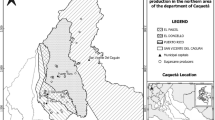Abstract
Abaca (Musa textilis) is a plant related to the banana, the leaves of which provide some of the strongest natural fibres used by man. It is indigenous to the Philippines, and grows well particularly in the provinces of Bicol, Samar and Leyte. Abaca is also one of the few cash crops that can grow with relatively little input compared to other crops, in steep forest areas. For this reason, it is often the crop of choice of households living in villages at the forest edge. The role of abaca in the household economy of villagers in Leyte is described. The study shows that abaca is both an important secondary income source of households with lowland farms, and frequently the only source of cash income of the poorest households in the community. The implications of abaca’s niche in the village economy, on increasing production of the crop, are discussed.
Similar content being viewed by others
References
Capistrano, A. D. and Marten, G.G. (1986), ‘Agriculture in Southeast Asia’, in G.G. Martin, ed., Traditional Agriculture in Southeast Asia: A Human Ecology Perspective, Westview Press, Boulder, pp. 6–19.
Department of Agriculture — Agribusiness and Marketing Assistance Service (2002), Abaca industry situationer report, Manila.
Escandor, J. (2001), ‘Bicol gears up for rising abaca exports’, Philippine Daily Inquirer, October 7, URL: http://www.ing/.net/bus/2001/oct/07/text/bus-2-1p.htm.
Foundation for the Advancement of Science Education (1996), Plants of the Philippines, 2nd edn., University of the Philippines Press, Manila.
NSO (National Statistics Office) (1996), 1994 Family income and expenditure survey: integrated survey of households bulletin series no. 80. Manila, Philippines.
Nishimura, S. (1996), ‘Agricultural development in Western Visayas: Pawned lands, overseas workers and porsiyentuhan’, in I. Ushijima and C.N. Zayas, eds., Binisaya nga Kinabuhi (Visayan Life), Visayas Maritime Anthropological Studies, University of the Philippines Press, Diliman, Quezon City, pp.59–72.
Olofson, H. (1983), ‘Indigenous Agroforestry Systems’, Philippine Quarterly of Culture and Society, 11(2/3): 149–174.
Philippine Council for Agriculture, Forestry and Natural Resources Research and Development (PCARRD) (1977), The Philippines Recommends for Abaca, Los Baños.
Seidenschwarz, F. (1994), Plant World of the Philippines, University of San Carlos Press, Cebu City.
Author information
Authors and Affiliations
Rights and permissions
About this article
Cite this article
Lacuna-Richman, C. The role of abaca (Musa textilis) in the household economy of a forest village. Small-scale Forestry 1, 93–101 (2002). https://doi.org/10.1007/s11842-002-0007-x
Issue Date:
DOI: https://doi.org/10.1007/s11842-002-0007-x




